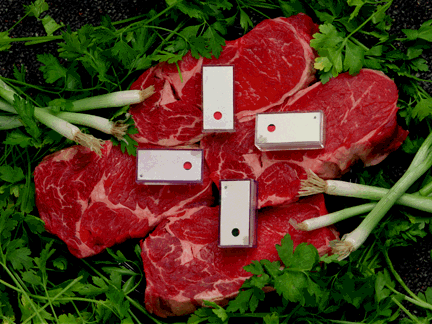Inexpensive thaw indicator determines food not fit to eat

If frozen food thawed on the cross-country truck transporting it, was then refrozen, and you bought it, how would you know it wasn’t fit to eat? Perhaps by a color change in a very inexpensive thaw indicator placed in the package.
WE REALLY PREFER PORTERHOUSE, but when meat has gone bad, we prefer the Sandia sensor, which can tell us so. The simple color code, which changes irreversibly from green to red when package temperatures top freezing, tells shoppers when food has been thawed and refrozen prior to sale. (Photo by Randy Montoya)
The indicator, originated and patented at Sandia, changes color when its temperature rises above 32 degrees F – the point above which harmful bacteria multiply. The color doesn’t change back if the temperature then drops below freezing, says David Martinez, Manager of Structural Dynamics Dept. 9234.
"Many inventions are simple," says University of New Mexico engineering professor Mo Shahinpoor. "It’s just that nobody thought of this before." Mo is a codeveloper with David of the temperature-detecting conceptual designs.
Byproduct of solar research
The invention, byproduct of a solar research project, depends upon an inexpensive "smart" material – a thin wire that "remembers" multiple shapes and acts as a sensor, says David.
Using no power source except warming or cooling, the wire changes shape markedly and powerfully at appropriate temperatures. When warmed, movement of the wire tears a colored paper, green, to reveal a different color beneath, red. When cooled, the wire returns to its prior position but because the paper is torn, the warning color remains visible.
David and Mo have developed eight preliminary designs, all patented, in which a smart-material sensor exposes a color-coded paper. The wire actuators utilize nitinol, a smart material consisting of nickel and titanium. Mo participates in the Sandia team working on projects in "smart" structures and materials.
Manufactured by the thousands or millions, the crucial element in the design – a wire about the size of a piece of thread less than 3/8 inches long – would cost "pennies for the raw materials," says David. "When there’s pressure from Washington on food processors and food transporters to protect consumers against spoiled food, we have a technology patented to do just that."
Jim Bickel, associate director of the New Mexico-based WERC (Waste Education and Research Consortium), says, "WERC is interested in commercializing certain technologies that concern food safety. We’re entering discussions with the US Department of Agriculture and the US Food and Drug Administration about several likely projects, including this one."
The consortium was established in 1990 by Sen. Pete Domenici, R-N.M., to benefit technologies that deal with environmental problems and to educate a workforce to deal with these problems.